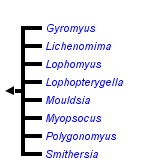Myopsocidae
Emilie Bess and Kevin P. Johnson


This tree diagram shows the relationships between several groups of organisms.
The root of the current tree connects the organisms featured in this tree to their containing group and the rest of the Tree of Life. The basal branching point in the tree represents the ancestor of the other groups in the tree. This ancestor diversified over time into several descendent subgroups, which are represented as internal nodes and terminal taxa to the right.

You can click on the root to travel down the Tree of Life all the way to the root of all Life, and you can click on the names of descendent subgroups to travel up the Tree of Life all the way to individual species.
For more information on ToL tree formatting, please see Interpreting the Tree or Classification. To learn more about phylogenetic trees, please visit our Phylogenetic Biology pages.
close boxIntroduction
The family Myopsocidae includes seven genera and nearly 200 species with worldwide distribution. Most species are tropical. Six species are known from North America in the genera Lichenomima and Myopsocus.
Myopsocids are fairly large bark lice (3-10 mm long, nymphs 2.5-3.5 mm) with robust bodies and distinct, heavily patterned wings. Body colors are dark or mottled. Myopsocids can be found living on tree bark and on shaded stone outcrops and cement structures.
Characteristics
Synapomorphies
- Female: gonapophyses have a very long dorsal valve.
- Forewings have characteristic heavily spotted pattern.
General Characters
- Head: Antennae have 13 segments
- Leg: Tarsi have 3 segments
- Wings:
- Forewings have characteristic heavily spotted pattern.
- Forewings are hairless.
- Forewing areola postica is connected to vein M.
- Hindwing is hairless.
- Male: Phallosome in one of two forms, either:
- closed anteriorly and posteriorly, tip is pointed, or
- composed of a pair of rods, not closed.
- Female:
- Subgenital plate has a single posterior lobe and broad pigmented arms.
- Gonapophyses are complete:
- Ventral valve is fine and pointed.
- Dorsal valve is very long and broad, terminating in a slender, pointed process.
- External valve is broad, rounded or squared, and setose.
- Eggs: Eggs laid in large groups and encrusted with debris.
How to Know the Family
- Fairly large bark lice, 3-10 mm.
- Forewings with characteristic heavily spotted pattern.
- Forewing areola postica is connected to vein M.
Family Monophyly
Monophyly of family Myopsocidae is supported by two morphological characters: forewings marked with distinct heavy spotting, and in the female, the gonapophyses with very long dorsal valve.
Discussion of Phylogenetic Relationships
There has been little work on the phylogenetic relationships within Myopsocidae.
Molecular analyses have raised questions about the relationship of Myposicidae to other families in infraorder Psocetae. Analysis of 18S nDNA placed Lichenomima as sister to Psocidae (Johnson et al. 2004). An expanded data set that included 18S nDNA, and 12S, 16S, and COI mtDNA found Lichenomima to be sister to Aaroniella (Philotarsidae), although this is the first study to question the placement of Myposocidae in Psocetae (Johnson and Mockford 2003).
References
Johnson, K. P. & E. L. Mockford. 2003. Molecular Systematics of Psocomorpha (Psocoptera). Systematic Entomology 28: 409-40.
Johnson, K. P., K. Yoshizawa, and V. S. Smith. 2004. Multiple origins of parasitism in lice. Proceedings of the Royal Society of London B 271:1771-1776.
Lienhard, C. and C. N Smithers. 2002. Psocoptera (Insecta) World Catalogue and Bibliography. Muséum d'Histoire Naturelle, Geneva, Switzerland.
Mockford, E. L. 1993. North American Psocoptera (Insecta). Gainesville, Florida: Sandhill Crane Press.
Mockford, E. L. 2005. Order Psocoptera: Psocids. Pp. 341-355 in C. A. Triplehorn and n. F. Johnson (eds.) Borror and DeLong's Introduction to the Study of Insects. Belmont, California: Thomson Publishing.
Smithers, C. N. 1996. Psocoptera. Pp. 1-80, 363-372 (Index) in A. Wells (ed.) Zoological Catalogue of Australia. Vol. 26. Psocoptera, Phthiraptera, Thysanoptera. Melbourne: CSIRO Publishing, Australia.
Yoshizawa, K. 2002. Phylogeny and higher classification of suborder Psocomorpha (Insecta: Psocodea:'Psocoptera'). Zoological Journal of the Linnean Society 136: 371-400.
About This Page
Emilie Bess

Illinois Natural History Survey, Champaign, Illinois, USA
Kevin P. Johnson

Illinois Natural History Survey, Champaign, Illinois, USA
Correspondence regarding this page should be directed to Emilie Bess at and Kevin P. Johnson at
Page copyright © 2009 Emilie Bess and Kevin P. Johnson
All Rights Reserved.
- First online 25 March 2009
- Content changed 25 March 2009
Citing this page:
Bess, Emilie and Kevin P. Johnson. 2009. Myopsocidae. Version 25 March 2009 (under construction). http://tolweb.org/Myopsocidae/14484/2009.03.25 in The Tree of Life Web Project, http://tolweb.org/





 Go to quick links
Go to quick search
Go to navigation for this section of the ToL site
Go to detailed links for the ToL site
Go to quick links
Go to quick search
Go to navigation for this section of the ToL site
Go to detailed links for the ToL site